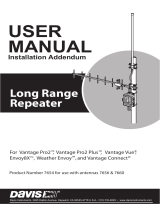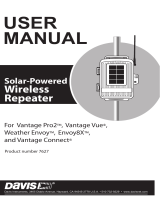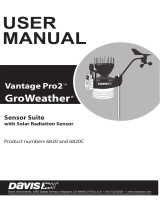
Vantage Pro2™ Long Range Wireless Repeater Addendum
Rev. C, July 1, 2014
Document Part Number: 07395.258
For Vantage Pro2 Long Range Wireless Repeater: 7654
Compatible with Vantage Pro2 Antennas: 7656, 7660
Vantage Pro2™, Vantage Vue®, Vantage Connect®, Weather Envoy™ and Envoy8X™ are trademarks of Davis
Instruments Corp., Hayward, CA.
© Davis Instruments Corp. 2014. All rights reserved.
Davis Instruments Quality Management System is ISO 9001 certified.
Information in this document subject to change without notice.
3465 Diablo Avenue, Hayward, CA 94545-2778 U.S.A.
510-732-9229 • Fax: 510-732-9188
®
Wireless Communication (OV, EU, UK models)
Transmit/Receive Frequency . . . . . . . . 868.0 - 868.6 MHz FHSS (Frequency Hopping
Spread Spectrum)
ID Codes Available . . . . . . . . . . . . . . . . 8
Output Power . . . . . . . . . . . . . . . . . . . . 868.0 - 868.6 MHz FHSS. CE-certified, less than
8 mW, no license required.Antenna gain can not
exceed 8 dBi maximum and no more than four
transmitter IDs to comply with the EN 300 220
regulation.
Range
Line of Sight . . . . . . . . . . . . . . . . . . . . up to 1.5 km (5000'), assuming a pair of 8 dBi
antennas
Contacting Davis Technical Support
For questions about installing or operationg your Long-Range Repeater, please contact
Davis Technical Support. We’ll be glad to help.
(510) 732-7814 Monday - Friday. 7:00 A.M. to 5:30 P.M., Pacific
Time. We are unable to accept collect calls.
(510) 670-0589 Technical Support Fax.
www.davisnet.com
Davis Instruments website. See the Weather
Support section for copies of manuals, product
specifications, application notes, and informa-
tion on software updates. Watch for FAQs and
other updates.



















